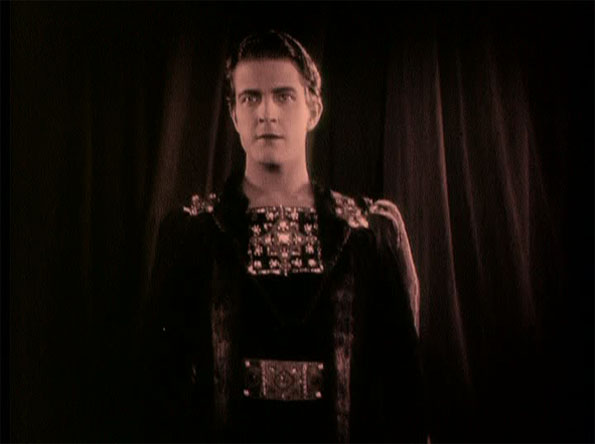
Greater Mexico’s Ramón Novarro: Between Latin Lover and Aztec Prince
Resumen
This article explores the construction of Ramón Novarro—the first Mexican actor to reach Hollywood stardom—as a “matinee idol” for women within multiple and competing, cultural discourses in Mexico City and Los Angeles. Looking at trade journals, periodicals catering to American, Mexican-American, and Mexican readerships, as well as Novarro’s starring role in Ben Hur: A Tale of the Christ (Fred Niblo, 1925), I trace the contradictory underpinnings shaping his star persona along class, ethnic, gendered, and sexed lines. Unlike that of Rudolph Valentino, Novarro’s star persona struck the right balance as an oddly de-eroticized Latin lover. This balance would allow for Novarro’s meteoric rise, within the growing nativist culture of mid-1920s Hollywood, against the backdrop of the Italian beau’s sudden fall.
Keywords: Latino Hollywood, Ramon Novarro, latin lover, illustrated periodicals, star studies.
____________
El Ramón Novarro de Greater México: Entre latin lover y príncipe azteca
Resumen: Este artículo explora la construcción de Ramón Novarro -el primer actor mexicano en alcanzar el estrellato en Hollywood- como matinee idol femenino en el marco discursos culturales antagónicos en las ciudades de México y Los Ángeles. A partir de periódicos dirigidos a públicos norteamericanos, mexicano-norteamericanos y mexicanos -y del estudio del rol del actor en Ben Hur (Fred Niblo, 1925)-, se identifican funciones contradictorias en la formación de la estrella en términos étnicos, de clase, de género y sexuales. A diferencia de Rudolph Valentino, Novarro encontró un punto medio como latin lover deserotizado que permitiría su ascenso dentro de la emergente cultura nativista del Hollywood de mediados de los años veinte, en contraste a la repentina caída del galán italiano.
Palabras clave: Hollywood Latino, Ramón Novarro, latin lover, periódicos ilustrados, estrellas de cine.
____________
Ramón Novarro, do Greater México: entre latin lover e príncipe asteca
Resumo: Este artigo explora a construção de Ramón Novarro -primeiro ator mexicano a chegar ao estrelato em Hollywood- como matinee idol para mulheres no contexto de discursos culturais antagônicos nas cidades do México e Los Angeles. Baseado em jornais voltados para o público americano, mexicano-americano e mexicano —além do papel do ator em Ben Hur (Fred Niblo, 1925)—, desenho as funções contraditórias da estrela em termos étnicos, de classe, de gênero e sexuais. Ao contrário de Rudolph Valentino, Novarro encontrou um ponto médio como um amante latino deserotizado que permitiria sua ascensão na emergente cultura nativista de Hollywood dos anos vinte, ao contrário da súbita queda do ator italiano.
Palavras-chave: Hollywood Latino, Ramón Novarro, latin lover, jornais ilustrados, estrelas de cinema.
____________
Fecha de recepción: 15 de agosto de 2019
Fecha de aceptación: 2 de diciembre de 2019
Texto completo:
PDF (English)Referencias
ALLEN, Robert C. “The Role of the Star in Film History (Joan Crawford).” In: Braudy, Leo and Marshall Cohen (eds.). Film Theory and Criticism. New York: Oxford University Press, 2009, pp.606–619.
BAILY, Samuel. “‘Hacer la América:’ los italianos ganan dinero en New York y Buenos Aires, 1880-1914,” Estudios Migratorios Latinoamericanos, vol. 14, n. 38 1998, pp 57–68.
BAZIN, André. “In Defense of Mixed Cinema.” In: What Is Cinema? Berkeley: University of California Press, 2004, pp. 53–75.
BELTRAN, Mary C. Latina/o Stars in U.S. Eyes: The Making and Meanings of Film and TV Stardom. Urbana: University of Illinois Press, 2009.
BENSON, Scott. “Ben-Hur: The Making of an Epic.” Turner Home Entertainment, 1993.
BERTELLINI, Giorgio. “Manipulation and Authenticity: The Unassibiliable Valentino in 1920s Argentina.” In: Navitski, Rielle and Nicholas Poppe (eds.). Cosmopolitan Film Cultures in Latin American, 1896-1960. Bloomington: Indiana University Press, 2017, pp. 73–97.
_____. “The Atlantic Valentino: The ‘Inimitable Lover’ As Racialized and Gendered Italian.” In: Baldassar, Loretta and Donna Gabaccia (eds.). Intimacy and Italian Migration: Gender and Domestic Lives in a Mobile World. New York: Fordham University, 2011.
BOSCHI, Alberto. “Significado Del Nuevo ‘Star System.’” In: Talens, Jenaro and Santos Zunzunegui (eds.). Historia General Del Cine: América (1915-1928). Madrid: Cátedra, pp. 331-376.
BRÉGENT-HEALD, Dominique. Borderland Films: American Cinema, Mexico, and Canada during the Progressive Era. Lincoln: University of Nebraska Press, 2015.
CHÁVEZ, Ernesto. “‘Ramon Is Not One of These:’ Race and Sexuality in the Construction of Silent Film Actor Ramón Novarro’s Star Image,” Journal of the History of Sexuality, vol. 20, n. 3, 2011, pp. 520–544.
DYER, Richard. Stars. London: BFI, 1998.
FINKIELMAN, Jorge. The Film Industry in Argentina. Jefferson, NC: McFarland, 2004.
GLEDHILL, Christine. “Prologue: The Reach of Melodrama.” In: Williams, Linda and Christine Gledhill (eds.). Melodrama Unbound: Across History, Media, and National Cultures. New York: Columbia University Press, 2018, pp. ix–xxv.
GONZÁLEZ MARÍN, Jesús Daniel. “¿Es que no sabes que eres un hombre? Star System y masculinidades en cinco actores del cine mexicano.” In: De los Reyes, Aurelio (ed.). Miradas al cine mexicano, pp. 369–391. México: IMCINE, 2016.
GUNCKEL, Colin. “Ambivalent Si(Gh)Tings: Stardom and Silent Film in Mexican America,” Film History, vol. 29, n. 1, 2017, pp. 110–139.
HANSEN, Miriam. “Pleasure, Ambivalence, Identification: Valentino and Female Spectatorship,” Cinema Journal, vol. 25, n. 4, 1986, pp. 6–32.
_____. “The Mass Production of the Senses: Classical Cinema as Vernacular Modernism,” Modernism/Modernity, vol. 6, n. 2, 1999, pp. 59–77.
_____. Babel and Babylon: Spectatorship in American Silent Film. Cambridge: Harvard University Press, 1991.
JARVIE, Ian C. “Stars and Ethnicity: Hollywood and the United States, 1932-1951.” In: Friedman, Lester (ed.). Unspeakable Images: Ethnicity and the American Cinema. Urbana: University of Illinois, 1991, pp. 82–111.
LÓPEZ, Ana. “Are All Latins from Manhattan?” In: Friedman, Lester (ed.). Unspeakable Images: Ethnicity and the American Cinema. Urbana: University of Illinois, 1991, pp. 404–424.
MIQUEL, Ángel. “Rafael Bermúdez Zataraín y el Magazine Fílmico”, Vivomatografías. Revista de estudios sobre precine y cine silente en Latinoamérica, n. 3, diciembre de 2017, pp. 46-70. Disponible en: http://www.vivomatografias.com/index.php/vmfs/article/view/119 [Access 10 October 2019].
MULVEY, Laura. “Visual Pleasure and Narrative Cinema.” In: Braudy, Leo and Marshall Cohen (eds.). Film Theory and Criticism. New York: Oxford University Press, 2009, pp. 833–844.
NAVITSKI, Rielle. Spectacles of Violence. Sensational Cinema and Journalism in Early Twentieth-Century Mexico and Brazil. Durham: Duke University Press, 2017.
PAZ, Octavio. El Laberinto de La Soledad. Mexico City: FCE, 1992.
RAMÍREZ BERG, Charles. “Stereotyping in Films in General and of the Hispanic in Particular,” Howard Journal of Communications, vol. 2, n. 3, 1990, pp. 286–300.
RODÓ, José Enrique. Ariel, Obras Completas. Madrid: Aguilar, 1967.
ROGIN, Michael. Black Face, White Noise. Berkeley: University of California Press, 1998.
SERNA, Laura Isabel. “Cinema on the US-Mexico Border: American Motion Picturesand Mexican Audiences, 1896-1930.” In: McCrossen, Alexis (ed.). Land of Necessity: Consumer Culture in the United States-Mexico Boderlands. Durham: Duke University Press, 2009, pp. 143-166.
_____. Making Cinelandia: American Films and Mexican Film Culture before the Golden Age, Durham/Londres: Duke University Press, 2014.
SERNA, Laura Isabel and Rielle Navitski. “Ephemerata,” Film History, vol. 29, n. 1, 2017, pp. 140–177.
SOARES, André. Beyond Paradise: The Life of Ramon Novarro. New York: St. Martin’s, 2002.
STUDLAR, Gaylyn. “Discourses of Gender and Ethnicity: The Construction and De(Con)Struction of Rudolph Valentino as Other,” Film Criticism, vol. 13, n. 2, 1989, pp. 18–35.
STURTEVANT, Victoria. “Spitfire: Lupe Velez and the Ambivalent Pleasures of Ethnic Masquerade,” The Velvet Light Trap, n. 55, 2005, pp. 19–32.
WINOKUR, Mark. “Improbable Ethnic Hero: William Powell and the Transformation of Ethnic Hollywood,”Cinema Journal, vol. 27, n. 1, 1987, pp. 5–22.
Enlaces refback
- No hay ningún enlace refback.
Copyright (c) 2019
Vivomatografías. Revista de estudios sobre precine y cine silente en Latinoamérica es una publicación de la Asociación de Estudios sobre Precine y Cine Silente Latinoamericano (PRECILA)
Esta revista se encuentra indexada en:
Síganos en:
Usamos:





















